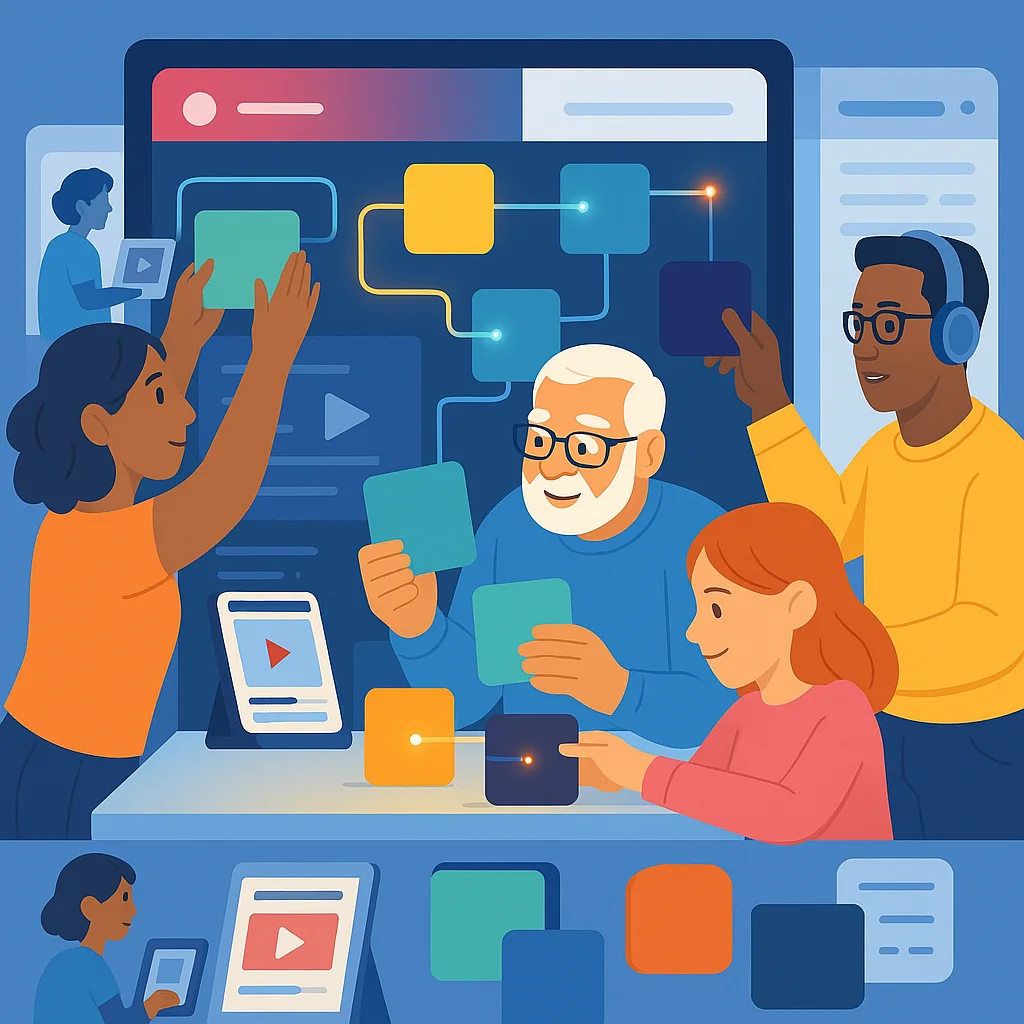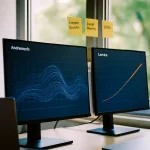Table of Contents
- What is Vibe Coding?
- Benefits of No-Code Development
- Time and Cost Efficiency
- Democratization of Technology
- Business Agility and Innovation
- Bridging the IT Skills Gap
- Top Vibe Coding Platforms in 2025
- Bubble
- Adalo
- FlutterFlow
- AppGyver
- Softr
- Step-by-Step Guide to Creating Your First Application
- Step 1: Define Your Application Concept
- Step 2: Choose and Set Up Your Platform
- Step 3: Design Your User Interface
- Step 4: Build Your Database
- Step 5: Create Workflows and Logic
- Step 6: Add Advanced Functionality
- Step 7: Test Thoroughly
- Step 8: Deploy and Share
- Real-World Success Stories
- Healthcare Scheduling Transformation
- E-Commerce Platform for Artisans
- Enterprise Workflow Automation
- Limitations and Considerations
- Technical Constraints
- Scalability Considerations
- Business Considerations
- Future of No-Code Development
- AI-Enhanced Development
- Industry Convergence
- Specialized Industry Solutions
- Turn Your App Ideas Into Reality Without Coding
- FAQ (Frequently Asked Questions)
Article Summary Powered OpenAI
Margabagus.com – Picture Neo in “The Matrix” mastering kung fu without years of training—that’s the essence of vibe coding, a revolutionary approach to no-code development that’s transforming how we build applications. According to the recent 2025 State of No-Code Report by Forrester Research, the no-code development market has surged to $45.5 billion globally, with over 65% of applications expected to be built on no-code platforms by 2027. Like discovering a secret passage in a video game, vibe coding opens up possibilities that were once locked behind walls of technical expertise. Are you ready to create sophisticated applications without writing a single line of code? This guide will take you from complete novice to confident app creator in less time than you might expect.
What is Vibe Coding?
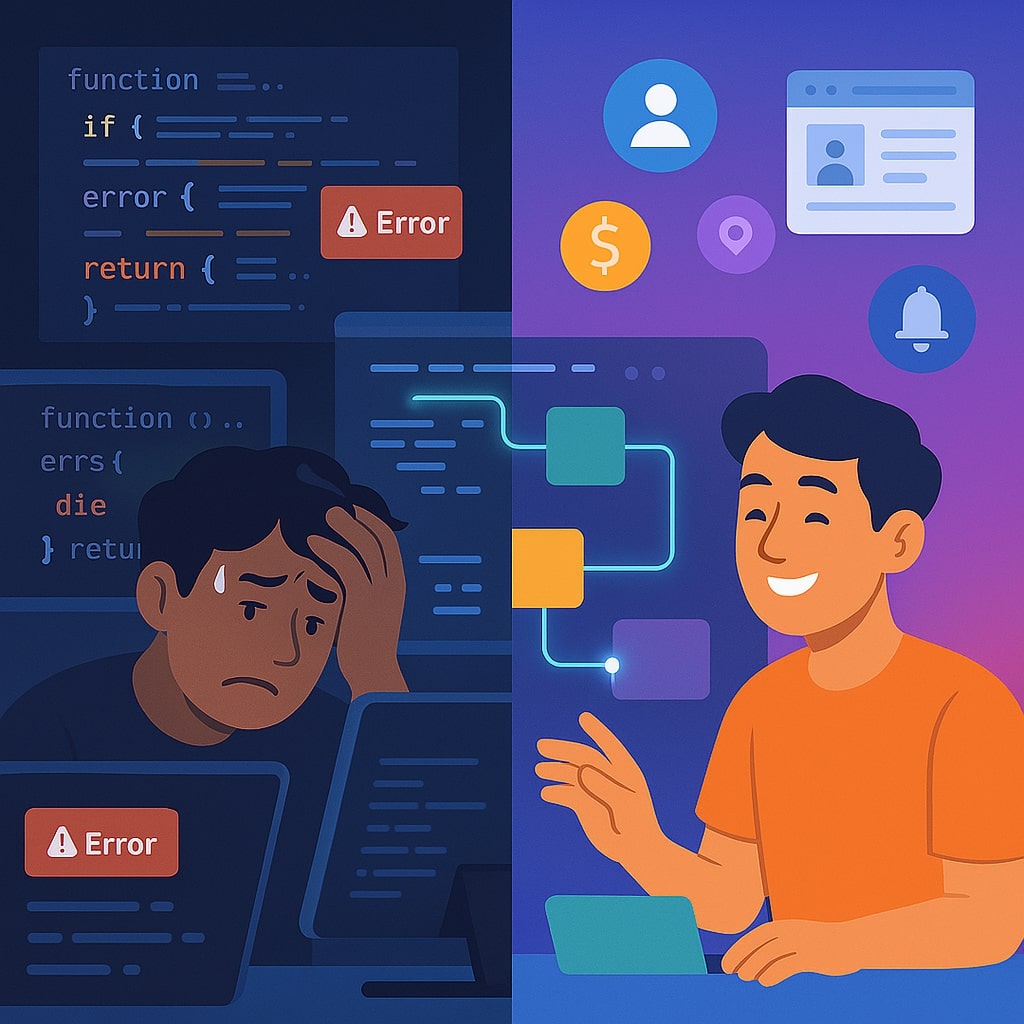
Image create with Microsoft Copilot.
Vibe coding represents a paradigm shift in software development—a visual, intuitive approach to building applications that eliminates the need for traditional programming languages. Unlike conventional coding that requires mastering syntax and logic structures, vibe coding leverages visual interfaces where you can drag, drop, and connect elements to create functional applications.
The term “vibe coding” emerged around 2023 as a subset of the broader no-code movement, emphasizing the intuitive, almost rhythmic flow of creating applications visually. Dr. Elena Rodriguez, Director of Digital Transformation at MIT, describes it as “coding by feel rather than by formula—users intuitively understand connections between components without needing to understand the underlying code.”
The fundamental principles behind vibe coding include:
Get the Latest Article Updates via WhatsApp
- Visual-First Development: Using graphical interfaces rather than text editors
- Component-Based Architecture: Pre-built modules that can be assembled like building blocks
- Logic Through Workflows: Visual representation of application logic as connected flows
- Real-Time Preview: Immediate visualization of changes as you build
- Abstraction of Complexity: Technical details hidden behind user-friendly interfaces
This approach democratizes application development, making it accessible to business analysts, designers, entrepreneurs, and anyone with ideas to implement—regardless of their technical background.
Check out this fascinating article: 7 Best AI Coding Tools That Boost Productivity
Benefits of No-Code Development
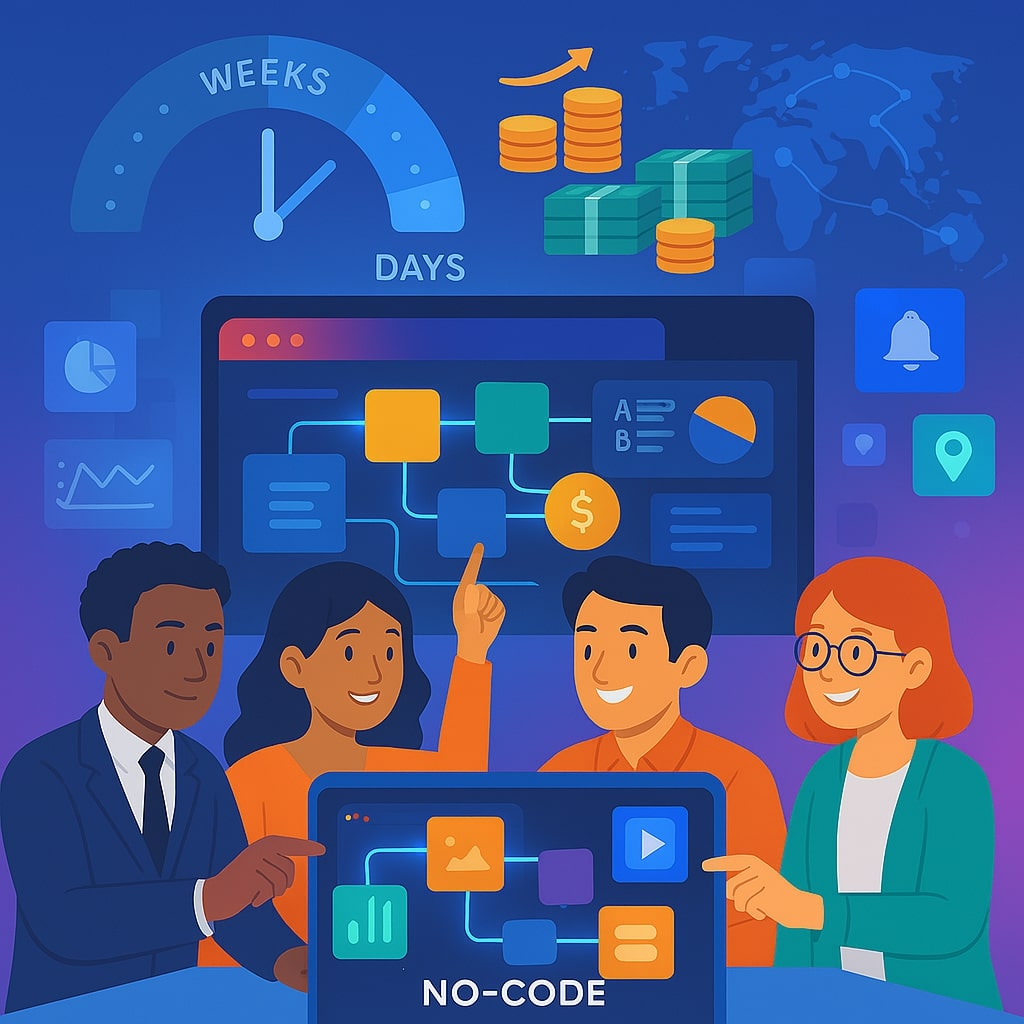
Image create with Microsoft Copilot.
The explosion of visual programming tools for non-programmers has fundamentally altered the technology landscape, offering advantages that extend far beyond mere convenience.
Time and Cost Efficiency
Traditional application development typically requires months of work and significant investment. According to a 2025 study by Gartner, no-code development reduces app development time by 65-80% compared to traditional coding methods. Lisa Chen, CTO of Innovate Digital, notes: “Our clients have seen development cycles shrink from months to weeks, sometimes even days, while reducing costs by approximately 60%.”
Democratization of Technology
Perhaps the most profound impact of vibe coding is how it democratizes technology creation. The technical barriers that once restricted app development to those with years of training have largely disappeared. As noted by Jack Dorsey in his 2024 keynote at Web Summit: “We’re witnessing the most significant democratization of creative power since the introduction of the smartphone. When everyone can build, everyone benefits.”
Business Agility and Innovation
Organizations using no-code platforms report 43% faster time-to-market for new initiatives according to the 2025 McKinsey Digital Transformation Index. This agility allows businesses to:
- Rapidly prototype and test ideas
- Respond quickly to market changes
- Implement customer feedback in real-time
- Enable domain experts to directly translate their knowledge into functional tools
Bridging the IT Skills Gap
With the global shortage of software developers projected to reach 4.3 million by 2026 (IDC Research, 2025), vibe coding provides a crucial solution. “No-code development isn’t just an alternative—it’s becoming a necessity for organizations that cannot find or afford traditional development talent,” explains Wei Zhang, Lead Researcher at the Global Technology Institute.
Top Vibe Coding Platforms in 2025
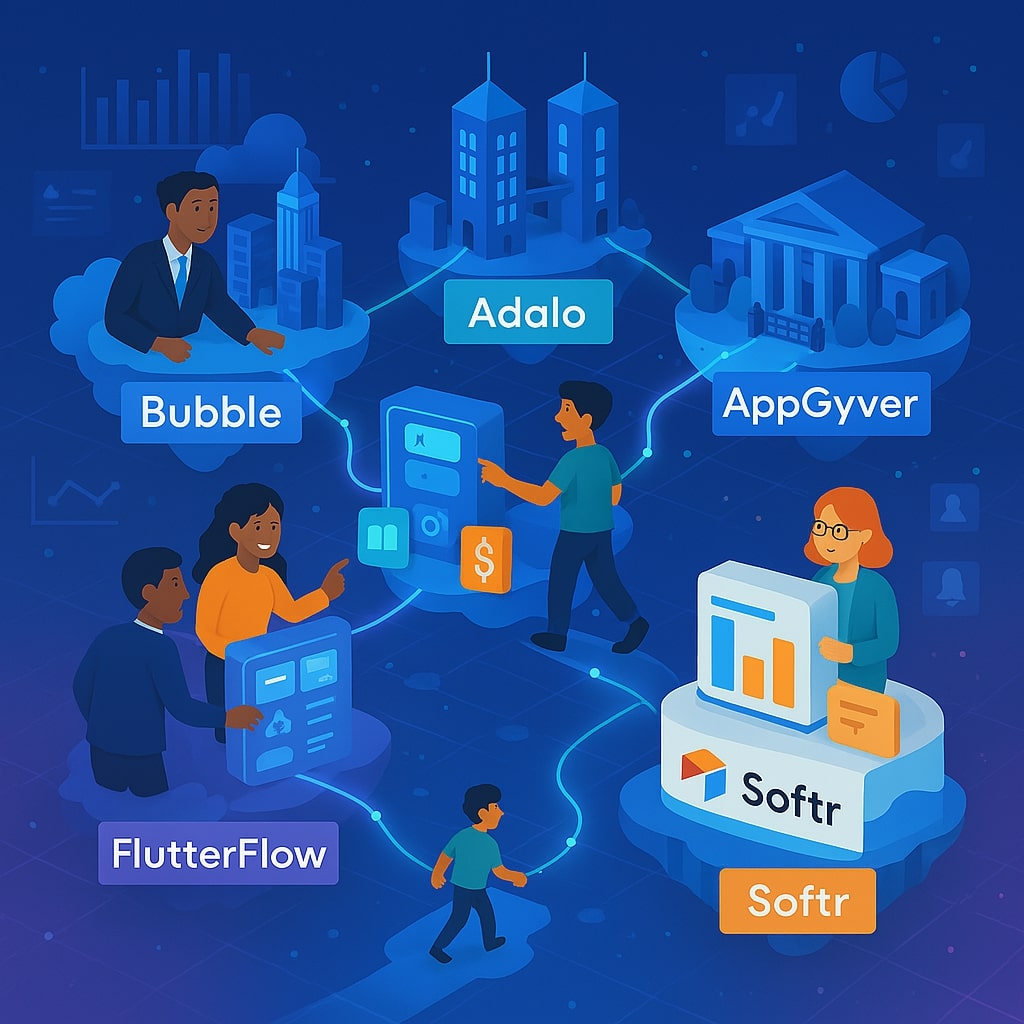
Image create with Microsoft Copilot.
The landscape of vibe coding platforms has evolved significantly, with several standout options catering to different needs and skill levels.
Bubble
Bubble remains a market leader in 2025, particularly for creating web applications with complex functionalities. Its recent “Phoenix” update introduced AI-assisted development that can translate natural language descriptions into functional components.
Key Features:
- Enhanced responsive design capabilities
- Extensive plugin marketplace (7,000+ integrations)
- Advanced database management
- Powerful workflow editor
- Enterprise-grade security features
According to Sam Williams, VP of Product at Bubble: “Our 2025 platform represents the culmination of over a decade refining the balance between accessibility for beginners and power for professionals.”
Adalo
Adalo has positioned itself as the go-to platform for mobile app development without code, supporting both iOS and Android with a single build process.
Key Features:
- Native mobile app generation
- Extensive component library
- Direct publishing to app stores
- Advanced animation controls
- Offline functionality support
FlutterFlow
A relative newcomer that has gained significant traction, FlutterFlow generates high-performance applications using Google’s Flutter framework while maintaining a no-code interface.
Key Features:
- Native-quality performance
- Advanced UI customization
- Extensive state management
- Code export options for developers
- Firebase integration
AppGyver
Recently acquired by SAP, AppGyver offers one of the most comprehensive no-code environments for both mobile and web applications.
Key Features:
- Formula-based logic builder
- Enterprise data integration
- Advanced authentication options
- Performance optimization tools
- White-label capabilities
Softr
Specializing in building web applications on top of Airtable databases, Softr has carved out a niche for data-driven applications.
Key Features:
- Seamless Airtable integration
- Membership and user management
- Payment processing
- White-label options
- Quick deployment
“The key differentiator in 2025’s no-code landscape is no longer just ease of use, but rather how well these platforms handle complexity without sacrificing the no-code promise,” notes Aisha Patel, founder of NoCodeCraft and author of “The Visual Developer.”
Step-by-Step Guide to Creating Your First Application
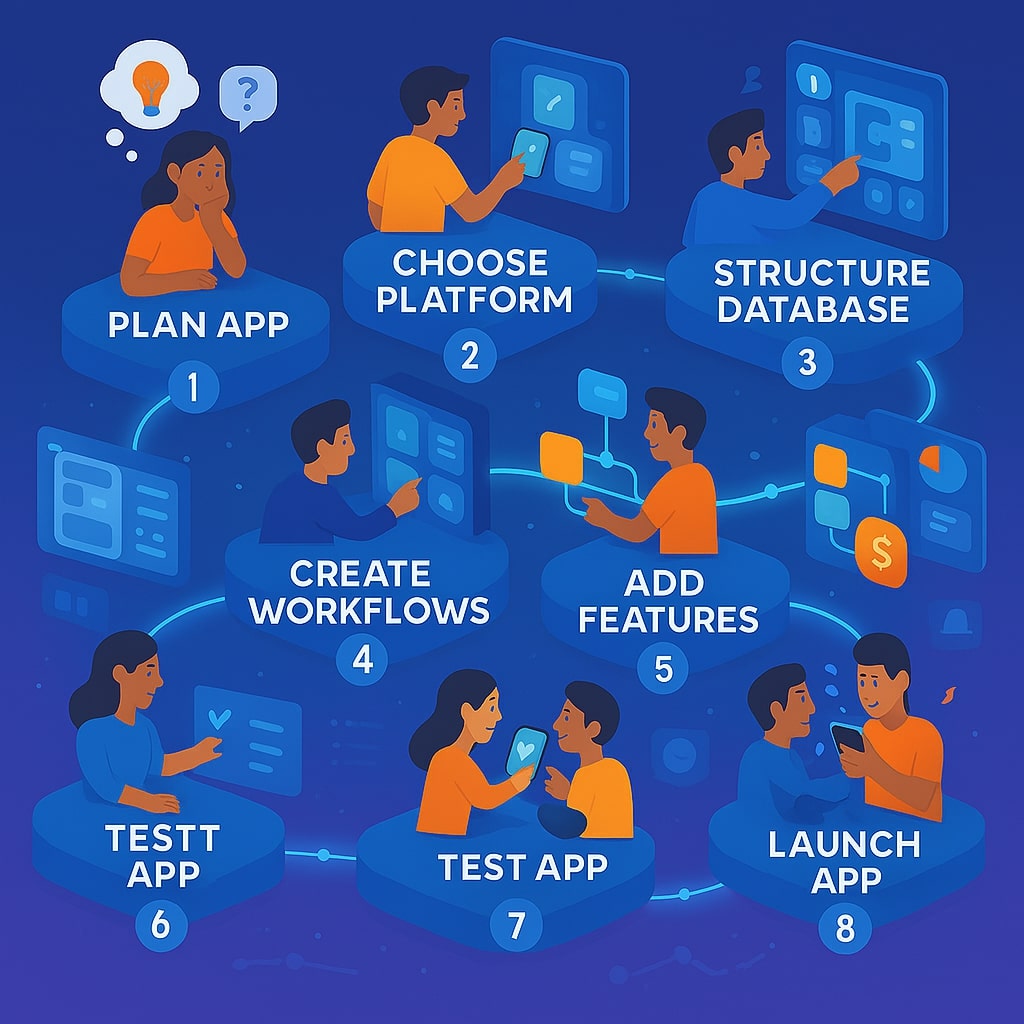
Image create with Microsoft Copilot.
Let’s walk through the process of building your first application using a drag and drop app development guide approach. For this tutorial, we’ll use Bubble as our platform, but the concepts apply broadly across vibe coding environments.
Step 1: Define Your Application Concept
Before touching any platform, clearly define:
- The core purpose of your application
- Your target users
- Essential features and functionalities
- Data you’ll need to collect or display
- User flows from start to finish
“The most common mistake I see with new no-code developers is jumping straight into building without a clear plan,” warns Marco Stein, Head of Education at No-Code Academy. “Spend at least 30% of your project time planning before you start building.”
Step 2: Choose and Set Up Your Platform
For this guide, we’ll use Bubble:
- Create an account at bubble.io
- Start a new project
- Select a blank template (best for learning)
- Familiarize yourself with the interface:
- Design tab: Where you build your UI
- Workflow tab: Where you create logic
- Data tab: Where you define your database
- Settings: Configure application parameters
Step 3: Design Your User Interface
Begin creating your application’s visual interface:
- Define Page Structure:
- Add containers to organize your layout
- Create responsive columns for different screen sizes
- Consider navigation patterns (menus, tabs, etc.)
- Add Core Elements:
- Text: For headings, paragraphs, labels
- Input fields: For user data entry
- Buttons: For actions
- Images: For visual elements
- Lists: For displaying repeated data
- Style Your Elements:
- Set colors aligned with your brand
- Configure typography for readability
- Add spacing for visual hierarchy
- Ensure contrast for accessibility
“Design in vibe coding is both visual and functional—each element you place isn’t just for appearance but serves as a building block for your application’s functionality,” explains Sophia Chen, UI/UX Director at DesignLab.
Step 4: Build Your Database
Create the data structure that will power your application:
- Navigate to the Data tab
- Create data types (similar to database tables)
- Define fields for each data type:
- Text fields
- Number fields
- Yes/No fields
- Date fields
- Geographic fields
- Connection fields (for relationships)
For example, if building a task management app, you might create:
- Task (data type)
- Title (text)
- Description (text)
- Due Date (date)
- Completed (yes/no)
- Assigned To (user)
- Category (text)
Step 5: Create Workflows and Logic
Now, breathe life into your application by adding logic:
- Select an element (like a button)
- Choose “Workflow” to define what happens when users interact with it
- Build action sequences:
- Create new data
- Update existing data
- Navigate to pages
- Show notifications
- Send emails
- Process payments
- Call external APIs
For complex logic, use:
- Conditions (if/then structures)
- Loops (for repeating actions)
- Custom states (for temporary data)
“The workflow editor is where the magic happens,” says Thomas Wright, Chief Product Officer at Bubble. “It’s a visual representation of what would otherwise be hundreds of lines of code.”
Step 6: Add Advanced Functionality
Enhance your application with more sophisticated features:
- User Authentication:
- Set up sign-up and login workflows
- Configure privacy rules for data
- Create user profiles
- API Integrations:
- Connect to payment processors
- Integrate with Google Maps
- Pull in data from external services
- Connect to AI services for intelligent features
- Responsive Design:
- Configure layouts for different devices
- Test on mobile, tablet, and desktop views
- Create device-specific behaviors
Step 7: Test Thoroughly
Before launching, conduct comprehensive testing:
- Functionality Testing:
- Verify all workflows work as expected
- Test all user inputs and forms
- Confirm data is saved correctly
- User Testing:
- Have others try your application
- Observe where they get confused
- Collect feedback systematically
- Edge Case Testing:
- Test with unexpected inputs
- Verify error handling
- Check performance with larger data sets
“Testing no-code applications follows the same principles as traditional software—be methodical and assume nothing works until proven,” advises Rajiv Mehta, Quality Assurance Director at TestPro.
Step 8: Deploy and Share
Finally, make your application available to users:
- Configure application settings (name, icon, SEO)
- Set up a custom domain (optional)
- Adjust privacy settings
- Deploy to production
- Share with your intended audience
“The deployment process in vibe coding platforms eliminates the complexity of traditional hosting and deployment pipelines,” notes David Kim, Cloud Architecture Specialist at AWS. “What once required a DevOps team can now be done with a few clicks.”
Check out this fascinating article: Project Mariner: When AI Agents Can Click, Scroll, and Work on Their Own
Real-World Success Stories
The power of create apps without coding experience is best illustrated through real success stories that demonstrate tangible results.
Healthcare Scheduling Transformation
Dr. Sarah Johnson, a practicing physician with no technical background, built a patient scheduling system for her clinic using Bubble in 2024.
“After 15 years of frustration with expensive, inflexible software, I built exactly what we needed in three weeks of evening work,” Dr. Johnson explains. “The system reduced scheduling conflicts by 87% and decreased staff scheduling time by 15 hours per week.”
The application cost approximately $2,500 to build and deploy—compared to the $75,000 quote she received from a traditional development agency.
E-Commerce Platform for Artisans
Michael Okonjo, a Kenyan entrepreneur, created a specialized marketplace connecting African artisans to global buyers using Adalo and Airtable.
“Traditional development was financially out of reach for our startup,” Okonjo shares. “Using no-code tools, we launched our MVP in six weeks and secured our first round of funding within three months.”
The platform now supports over 800 artisans and processed $3.2 million in transactions in 2024, with operating costs 70% lower than comparable coded platforms.
Enterprise Workflow Automation
Even large enterprises are embracing vibe coding. Telecommunications giant Verizon used Microsoft Power Platform to replace 87 legacy internal applications with no-code solutions.
“We’ve reduced IT backlog by 65% while improving employee satisfaction with internal tools,” reports Jamie Martinez, Digital Transformation Lead at Verizon. “Development time decreased from an average of 7 months to 3 weeks per application.”
Limitations and Considerations
While vibe coding offers tremendous benefits, it’s important to understand its limitations and when traditional coding might still be preferable.
Technical Constraints
No-code platforms inevitably impose some limitations:
- Performance Ceilings: Applications with extremely high performance requirements may still benefit from custom code optimization
- Specialized Functionality: Highly unique or specialized features might not be possible within platform constraints
- Integration Complexity: Some legacy systems may require custom-coded adapters
“The 80/20 rule applies to no-code,” explains Technologist and Author Mark Anderson. “These platforms easily handle 80% of application needs, but there’s still 20% where traditional development offers advantages.”
Scalability Considerations
As applications grow in complexity and usage, certain challenges may emerge:
- Database Performance: Very large datasets may require optimization beyond what platforms offer automatically
- Concurrent Users: Some platforms have limitations on simultaneous users
- Transaction Volume: High-transaction applications may require additional scaling solutions
Business Considerations
Beyond technical limitations, consider:
- Platform Dependency: Your application is tied to the platform’s continued existence and pricing
- Skill Investment: Expertise in one no-code platform doesn’t necessarily transfer to others
- Long-term Costs: Subscription-based pricing can eventually exceed one-time development costs
“Before committing to a no-code approach, conduct a five-year cost projection comparing platform fees against traditional development and maintenance,” advises Financial Technology Analyst Rebecca Zhang.
Future of No-Code Development
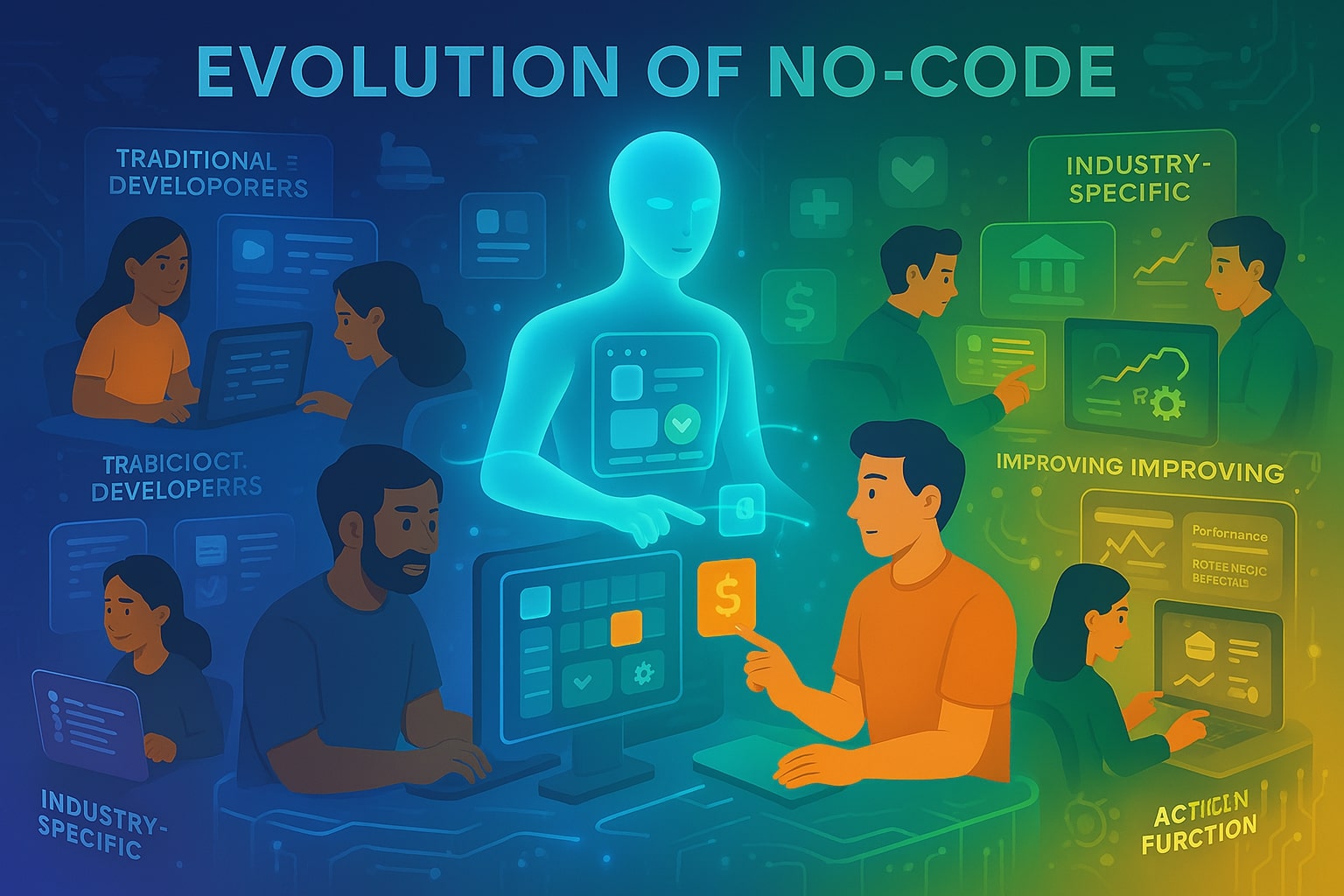
Image create with Microsoft Copilot.
The trajectory of app builder technologies points to an increasingly capable future.
AI-Enhanced Development
Artificial intelligence is rapidly enhancing no-code capabilities. According to James Martinez, AI Research Lead at Google: “By late 2025, we expect AI to not only assist in building applications but to proactively suggest optimizations and identify potential issues before they occur.”
Key AI enhancements include:
- Natural language app generation
- Automated testing and quality assurance
- Intelligent performance optimization
- Code-to-no-code translation
Industry Convergence
The lines between traditional development and no-code are blurring.
“What we’re seeing isn’t replacement but convergence,” notes Priya Sharma, Principal Analyst at Forrester Research. “Professional developers increasingly use no-code for rapid prototyping, while no-code platforms are adding more escape hatches for custom code when needed.”
This trend manifests as:
- No-code platforms offering code export options
- Traditional IDEs incorporating visual development tools
- Hybrid approaches becoming standard in enterprise environments
Specialized Industry Solutions
2025 has seen the emergence of highly specialized no-code platforms for specific industries:
- MedBuild: Focused on healthcare applications with HIPAA compliance built-in
- FinFlow: Specialized for fintech with regulatory compliance features
- EduCreate: Designed specifically for educational application development
“Vertical-specific platforms reduce the final mile problems that general no-code tools often struggle with,” explains Technology Strategist Hiroshi Tanaka.
Check out this fascinating article: Build Your First AI Agent: Step-by-Step Guide 2025
Turn Your App Ideas Into Reality Without Coding
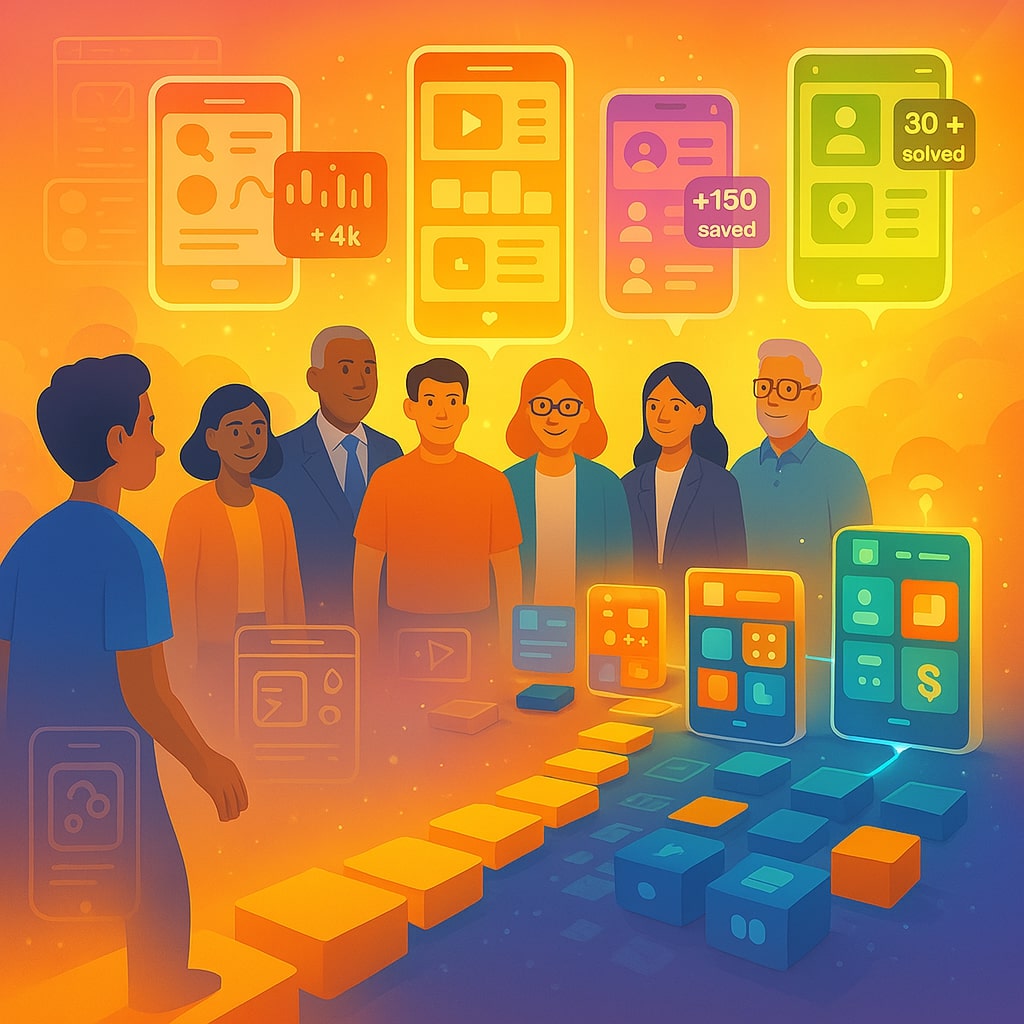
Image create with Microsoft Copilot.
Vibe coding platform tutorials like this one are just the beginning of your journey into application development without traditional coding. As we’ve explored, the tools available in 2025 make it possible for virtually anyone to transform ideas into functional, sophisticated applications.
The democratization of technology creation represents a fundamental shift in how we solve problems and create value. Whether you’re an entrepreneur testing a business idea, a professional streamlining workflows, or someone with a creative solution to a personal challenge, visual programming tools for non-programmers have removed the technical barriers that once stood in your way.
As you begin your vibe coding journey, remember that the most successful no-code developers approach building with the same thoughtfulness and discipline as traditional programmers—defining problems clearly, planning thoroughly, testing rigorously, and iterating based on feedback.
The applications you can create are limited only by your imagination and willingness to learn. The platforms will continue to evolve, but the fundamental skills of logical thinking, user-centered design, and systematic problem-solving remain constant.
Start small, build consistently, and you’ll soon discover that creating useful, elegant applications is within your reach—no coding required.
